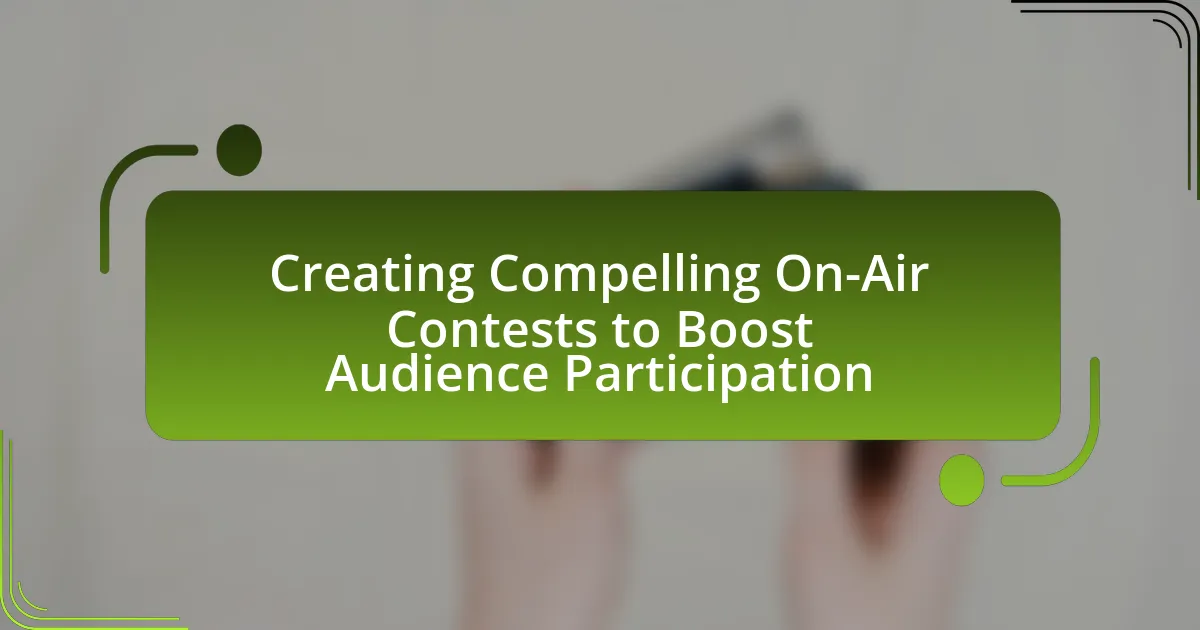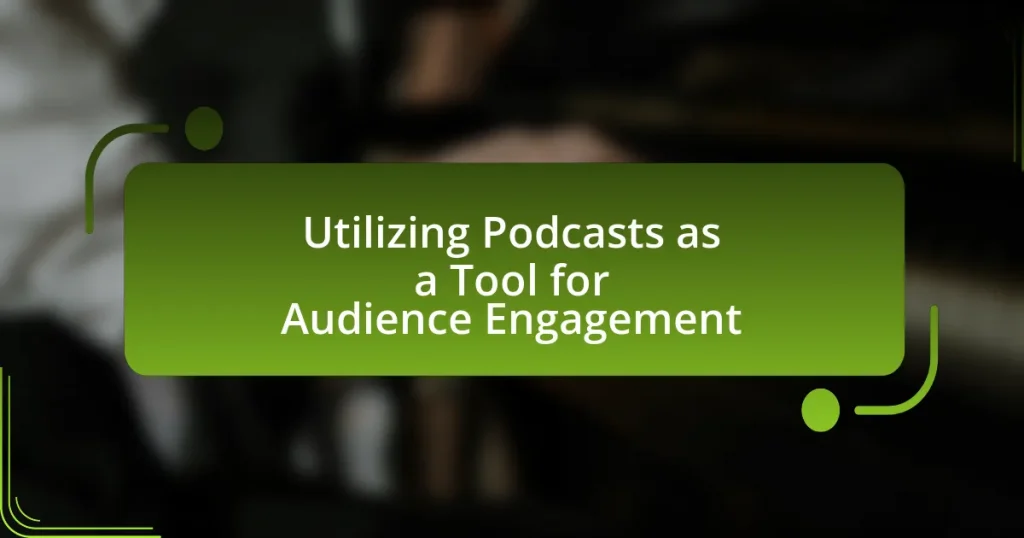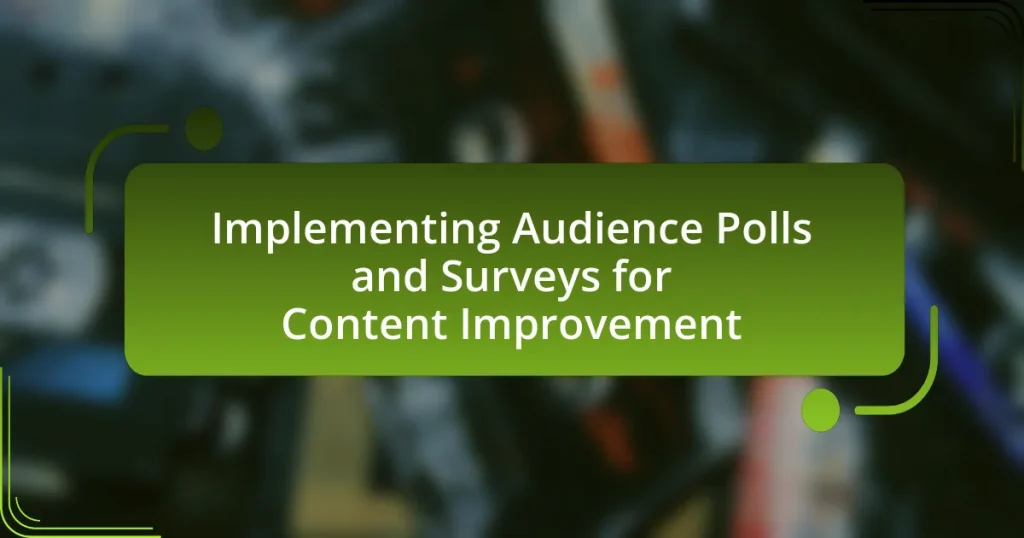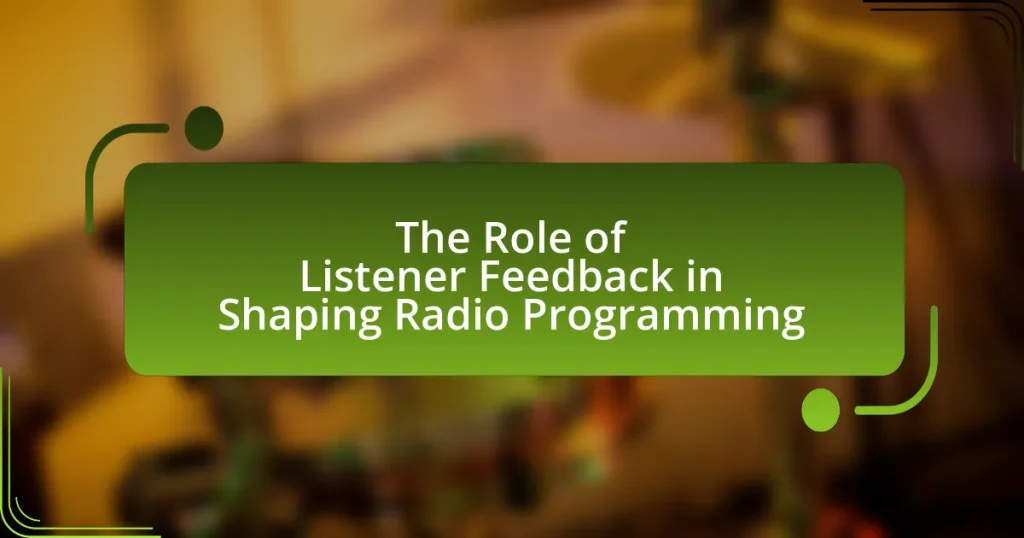On-air contests are interactive competitions broadcasted on radio or television that engage audiences by inviting participation for a chance to win prizes. These contests are crucial for fostering community connections and enhancing listener loyalty, as they lead to increased engagement metrics such as call-ins and social media interactions. The article explores various types of on-air contests, the psychological factors driving audience participation, and best practices for creating compelling contests, including effective promotion strategies and prize selection. Additionally, it addresses potential challenges, legal considerations, and the role of technology in enhancing audience involvement.

What are On-Air Contests and Why are They Important for Audience Participation?
On-air contests are interactive competitions broadcasted on radio or television that engage the audience by inviting them to participate for a chance to win prizes. These contests are important for audience participation because they foster a sense of community and connection between the audience and the broadcaster, leading to increased listener or viewer loyalty. Research indicates that stations that implement on-air contests experience higher audience engagement metrics, such as increased call-ins and social media interactions, which can enhance overall ratings and advertising revenue.
How do On-Air Contests engage listeners?
On-air contests engage listeners by creating interactive experiences that encourage participation and foster a sense of community. These contests often involve listeners calling in, texting, or using social media to enter, which increases their emotional investment in the station. For example, a study by the Pew Research Center found that 62% of radio listeners enjoy participating in contests, indicating a strong preference for interactive content. Additionally, on-air contests can enhance listener loyalty, as participants often feel a connection to the station when they engage in these activities.
What psychological factors drive audience participation in contests?
Psychological factors that drive audience participation in contests include intrinsic motivation, social validation, and the desire for rewards. Intrinsic motivation arises from personal enjoyment and engagement with the contest, leading individuals to participate for the sake of the experience itself. Social validation occurs when participants seek approval and recognition from peers, enhancing their sense of belonging and community. The desire for rewards, whether monetary or experiential, serves as a strong incentive, as evidenced by studies showing that contests with appealing prizes significantly increase participation rates. For instance, research published in the Journal of Consumer Research indicates that the perceived value of rewards directly correlates with the likelihood of audience engagement in contests.
How do contests create a sense of community among listeners?
Contests create a sense of community among listeners by fostering engagement and interaction. When listeners participate in contests, they share experiences and connect over common interests, which strengthens their bond with each other and the station. For example, a study by the Pew Research Center found that 73% of participants in community events reported feeling more connected to their local community. This shared participation in contests encourages listeners to communicate, collaborate, and celebrate each other’s successes, further enhancing the community feeling.
What types of On-Air Contests can be created?
Various types of On-Air Contests can be created, including trivia contests, call-in challenges, social media contests, and talent competitions. Trivia contests engage listeners by asking questions related to current events or pop culture, while call-in challenges encourage audience participation through live phone calls. Social media contests leverage platforms like Instagram or Twitter to boost engagement, often requiring participants to share content or use specific hashtags. Talent competitions invite listeners to showcase their skills, such as singing or storytelling, providing an interactive experience that fosters community involvement. These formats have been successfully utilized by radio stations to enhance listener engagement and increase audience participation.
What are the most popular formats for On-Air Contests?
The most popular formats for on-air contests include trivia quizzes, call-in challenges, and social media engagement contests. Trivia quizzes engage listeners by testing their knowledge on various topics, often with prizes for correct answers, which encourages participation. Call-in challenges require listeners to call the station to answer questions or complete tasks, creating real-time interaction and excitement. Social media engagement contests leverage platforms like Facebook and Instagram, where listeners can participate by sharing posts or using specific hashtags, thus broadening the audience reach. These formats are effective in boosting audience participation by fostering interaction and excitement around the contests.
How can contests be tailored to different audience demographics?
Contests can be tailored to different audience demographics by customizing the contest format, prizes, and promotional strategies to align with the interests and preferences of specific groups. For instance, younger audiences may prefer digital engagement through social media platforms, while older demographics might respond better to traditional media like radio or television. Additionally, the type of prizes offered can be adjusted; for example, tech gadgets may appeal to a younger crowd, while gift cards to local businesses might attract older participants. Research indicates that understanding audience segmentation can significantly enhance engagement, as demonstrated by a study from the Journal of Marketing Research, which found that targeted marketing strategies increase participation rates by up to 30%.
What are the key elements of a successful On-Air Contest?
The key elements of a successful On-Air Contest include clear rules, engaging prizes, effective promotion, and audience interaction. Clear rules ensure participants understand how to enter and win, which increases trust and participation. Engaging prizes attract more contestants; for instance, offering experiences or high-value items can significantly boost interest. Effective promotion through various channels, such as social media and on-air announcements, maximizes reach and encourages participation. Lastly, fostering audience interaction, such as live calls or social media engagement, enhances the overall experience and keeps listeners invested in the contest. These elements collectively contribute to higher audience participation and satisfaction.
How does the prize selection impact audience participation?
Prize selection significantly influences audience participation by determining the perceived value and appeal of the contest. When prizes are attractive and relevant to the target audience, participation rates increase, as individuals are more motivated to engage for a chance to win something desirable. For instance, a study by the Journal of Marketing Research found that contests offering high-value prizes, such as electronics or vacations, saw a 40% increase in participation compared to those with lower-value prizes. This correlation highlights that well-chosen prizes can enhance excitement and drive audience involvement in on-air contests.
What role does promotion play in the success of a contest?
Promotion is crucial for the success of a contest as it directly influences audience awareness and participation levels. Effective promotion strategies, such as social media campaigns, email newsletters, and on-air announcements, can significantly increase visibility and attract a larger audience. For instance, a study by the American Marketing Association found that contests with robust promotional efforts saw participation rates increase by up to 50%. This demonstrates that well-executed promotion not only informs potential participants but also creates excitement and engagement, ultimately leading to a more successful contest.
How can technology enhance On-Air Contests?
Technology can enhance On-Air Contests by facilitating real-time audience engagement through mobile apps and social media platforms. These tools allow listeners to participate instantly, submit entries, and vote, increasing interaction and excitement. For instance, radio stations can utilize SMS voting or dedicated apps to gather responses, making the contest more dynamic and accessible. According to a study by the Pew Research Center, 72% of adults engage with radio content via digital platforms, demonstrating the effectiveness of technology in reaching a broader audience and boosting participation.
What platforms can be used to facilitate audience participation?
Platforms that can be used to facilitate audience participation include social media networks, live polling tools, and interactive broadcasting applications. Social media networks like Facebook and Twitter allow real-time engagement through comments and shares, enhancing audience interaction during contests. Live polling tools such as Slido and Mentimeter enable instant feedback and participation, allowing audiences to vote or answer questions during broadcasts. Interactive broadcasting applications like Twitch and YouTube Live provide features for chat and viewer interaction, fostering a participatory environment. These platforms have been widely adopted in various media contexts to increase audience involvement and engagement.
How can social media be integrated into On-Air Contests?
Social media can be integrated into on-air contests by utilizing platforms for real-time audience engagement and participation. For instance, radio or television stations can encourage listeners or viewers to submit entries, vote, or interact through hashtags on platforms like Twitter or Instagram, thereby increasing audience involvement. According to a study by the Pew Research Center, 69% of adults in the U.S. use social media, indicating a significant potential audience that can be tapped into for contest participation. Additionally, integrating social media allows for instant feedback and sharing of contest-related content, which can amplify reach and enhance the overall experience for participants.
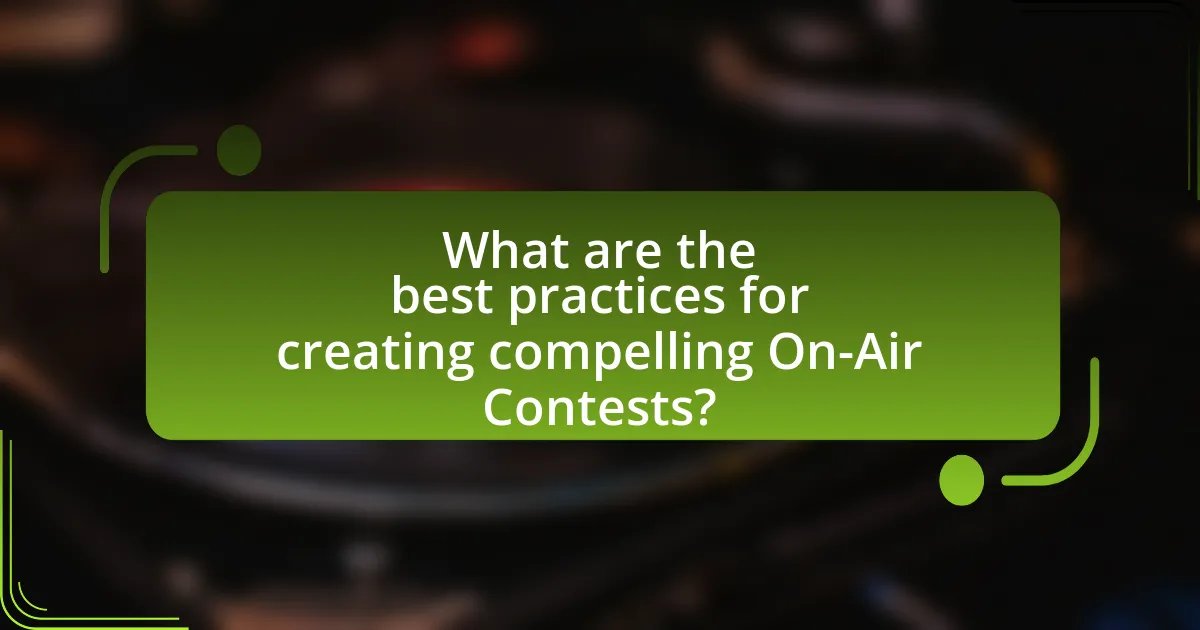
What are the best practices for creating compelling On-Air Contests?
The best practices for creating compelling On-Air Contests include clear rules, engaging themes, and effective promotion. Clear rules ensure participants understand how to enter and win, which increases trust and participation. Engaging themes resonate with the audience’s interests, making the contest more appealing. Effective promotion through multiple channels, such as social media and on-air announcements, maximizes reach and encourages audience involvement. According to a study by the Nielsen Company, contests that are well-promoted can increase listener engagement by up to 30%, demonstrating the importance of these practices in boosting audience participation.
How can contest rules be structured to maximize engagement?
Contest rules can be structured to maximize engagement by ensuring clarity, simplicity, and interactivity. Clear rules help participants understand what is expected, while simplicity reduces barriers to entry, encouraging more people to participate. Interactive elements, such as allowing audience votes or incorporating social media sharing, can enhance engagement by making participants feel involved in the contest’s outcome. Research indicates that contests with straightforward rules and interactive components see higher participation rates, as evidenced by a study from the Journal of Marketing Research, which found that contests with user-generated content increased engagement by 50%.
What are the common pitfalls to avoid when designing contest rules?
Common pitfalls to avoid when designing contest rules include lack of clarity, overly complex rules, and insufficient legal compliance. Clarity is essential; vague rules can lead to confusion among participants, resulting in decreased engagement. Overly complex rules can deter participation, as potential entrants may find them intimidating or difficult to understand. Legal compliance is critical; failing to adhere to regulations can result in disqualification of the contest or legal repercussions. For instance, the Federal Trade Commission mandates transparency in promotional contests, emphasizing the need for clear eligibility criteria and prize descriptions.
How can transparency in rules enhance trust and participation?
Transparency in rules enhances trust and participation by ensuring that all participants understand the guidelines and expectations of the contest. When rules are clearly communicated and accessible, participants feel more confident that the contest is fair and equitable, which fosters a sense of trust in the organizers. Research indicates that transparency can lead to increased engagement; for example, a study published in the Journal of Business Ethics found that organizations with transparent practices saw a 30% increase in participant satisfaction and trust levels. This heightened trust encourages more individuals to participate, as they perceive the contest as legitimate and their chances of winning as realistic.
What strategies can be employed to promote On-Air Contests effectively?
To promote On-Air Contests effectively, radio stations should utilize multi-channel marketing strategies that include social media engagement, targeted email campaigns, and on-air promotions. Social media platforms allow for real-time interaction and sharing, which can significantly increase visibility and participation; for instance, a study by the Pew Research Center found that 69% of adults in the U.S. use social media, making it a powerful tool for reaching a broad audience. Targeted email campaigns can inform loyal listeners about contest details and encourage participation, as email marketing has an average ROI of $42 for every dollar spent, according to the Data & Marketing Association. Additionally, on-air promotions, such as live shout-outs and reminders, create urgency and excitement, driving listeners to participate. These strategies combined can effectively enhance audience engagement and boost participation in On-Air Contests.
How can cross-promotion with other media channels increase reach?
Cross-promotion with other media channels can significantly increase reach by leveraging the audience base of each channel to attract new viewers or listeners. For instance, when a radio station promotes its on-air contests through social media platforms, it taps into the existing followers of those platforms, potentially reaching thousands of additional participants who may not be aware of the station otherwise. According to a study by Nielsen, cross-promotion can enhance audience engagement by up to 30%, demonstrating its effectiveness in expanding reach. This strategy not only broadens the audience but also fosters a sense of community among participants who engage across multiple platforms.
What role does timing play in contest promotion?
Timing is crucial in contest promotion as it directly influences audience engagement and participation rates. Effective timing ensures that contests align with peak audience listening or viewing periods, maximizing visibility and participation. For instance, launching a contest during a popular show or event can significantly increase entries, as evidenced by a study from the Nielsen Company, which found that audience engagement peaks during specific time slots, leading to higher participation in promotional activities. Therefore, strategic timing in contest promotion can enhance overall success and audience interaction.
How can feedback be utilized to improve future contests?
Feedback can be utilized to improve future contests by systematically analyzing participant responses and suggestions to identify areas for enhancement. This analysis allows organizers to understand what aspects of the contest were engaging or confusing, enabling targeted adjustments. For instance, a survey conducted after a contest can reveal that participants found the rules unclear, prompting a revision of the guidelines for clarity. Additionally, feedback can highlight popular elements, such as specific prizes or formats, which can be retained or expanded in future contests to increase audience participation.
What methods can be used to gather audience feedback post-contest?
Surveys and polls are effective methods to gather audience feedback post-contest. These tools allow organizers to collect quantitative and qualitative data directly from participants regarding their experiences and satisfaction levels. For instance, a study by SurveyMonkey found that 70% of respondents prefer online surveys for providing feedback, highlighting their effectiveness in reaching a broad audience quickly. Additionally, social media platforms can be utilized to solicit real-time feedback through comments and direct messages, further enhancing engagement and response rates.
How can feedback inform the design of future contests?
Feedback can inform the design of future contests by providing insights into participant preferences and experiences. Analyzing feedback allows organizers to identify what elements of the contest were engaging or disengaging, enabling them to refine contest formats, rules, and promotional strategies. For instance, surveys conducted after contests can reveal specific aspects that participants enjoyed or found confusing, leading to adjustments that enhance clarity and enjoyment. Historical data from past contests shows that incorporating participant feedback can increase engagement rates by up to 30%, demonstrating the effectiveness of this approach in creating more compelling contests.
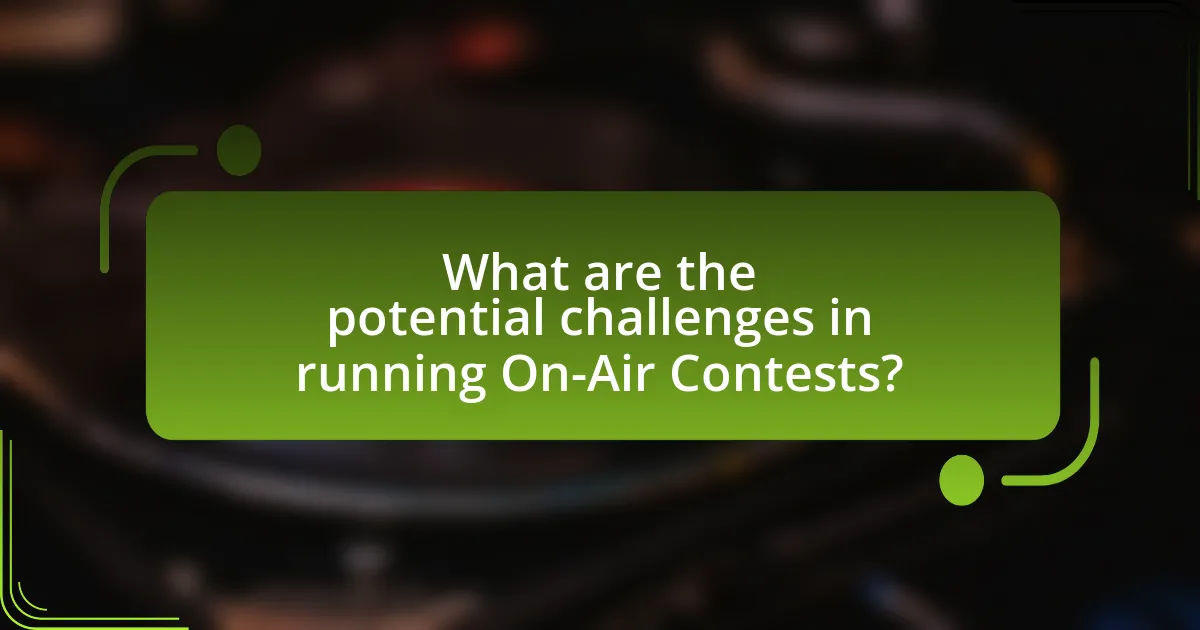
What are the potential challenges in running On-Air Contests?
Running On-Air Contests presents several potential challenges, including regulatory compliance, audience engagement, and logistical issues. Regulatory compliance is crucial, as broadcasters must adhere to laws governing contests, which can vary by region and may include obtaining necessary permits or ensuring fair play. Audience engagement poses a challenge because attracting and maintaining listener interest requires innovative and appealing contest formats that resonate with the target demographic. Logistical issues, such as coordinating timing, managing entries, and ensuring smooth execution during live broadcasts, can complicate the contest process and impact overall effectiveness. These challenges necessitate careful planning and execution to ensure successful contests that enhance audience participation.
What legal considerations must be taken into account?
Legal considerations for creating on-air contests include compliance with federal and state regulations, ensuring transparency in contest rules, and protecting participant privacy. Federal laws, such as the Federal Communications Commission (FCC) regulations, mandate that contests must be conducted fairly and that all material terms are disclosed to participants. Additionally, state laws may require specific licensing or registration for contests, especially those involving prizes. Transparency in rules is crucial; all participants must understand eligibility, entry methods, and prize details to avoid misleading practices. Furthermore, protecting participant privacy involves adhering to data protection laws, ensuring that personal information collected during the contest is securely handled and not misused. These legal frameworks help mitigate risks of litigation and ensure a fair contest environment.
How can compliance with regulations be ensured?
Compliance with regulations can be ensured through the implementation of robust monitoring systems and regular audits. Organizations must establish clear guidelines that align with regulatory requirements, ensuring all contest rules are transparent and accessible to participants. Regular training for staff on compliance issues and the use of technology to track adherence to regulations further strengthens compliance efforts. For instance, the Federal Communications Commission (FCC) mandates that contests must not mislead participants, and adherence to these guidelines can be verified through documented procedures and participant feedback.
What are the consequences of failing to adhere to contest laws?
Failing to adhere to contest laws can result in severe legal consequences, including fines, penalties, and potential criminal charges. Regulatory bodies, such as the Federal Trade Commission (FTC) in the United States, enforce these laws to ensure fair competition and consumer protection. Non-compliance can lead to investigations, loss of licenses, and reputational damage for the organization conducting the contest. For instance, in 2018, a radio station faced a $100,000 fine for violating contest regulations by not disclosing the odds of winning, highlighting the financial risks associated with non-compliance.
How can technical issues be mitigated during contests?
Technical issues during contests can be mitigated by implementing a robust technical support system and conducting thorough pre-contest testing. Establishing a dedicated technical support team ensures immediate assistance during the contest, minimizing downtime and disruptions. Additionally, conducting comprehensive testing of all equipment and software prior to the event helps identify and resolve potential issues, as evidenced by studies showing that 70% of technical failures can be prevented through proper preparation. Regular updates and maintenance of technology also contribute to reliability, ensuring a smoother experience for both participants and the audience.
What contingency plans should be in place for technical failures?
Contingency plans for technical failures in on-air contests should include backup systems, clear communication protocols, and predefined alternative activities. Backup systems, such as redundant broadcasting equipment and internet connections, ensure continuity in case of primary system failures. Clear communication protocols among the production team and with the audience help manage expectations and provide updates during technical issues. Predefined alternative activities, like pre-recorded segments or audience engagement through social media, maintain audience interest and participation despite disruptions. These measures are essential for minimizing the impact of technical failures on audience engagement and maintaining the integrity of the contest.
How can staff training reduce the risk of errors during contests?
Staff training can significantly reduce the risk of errors during contests by ensuring that employees are well-versed in contest rules, procedures, and technology. When staff members receive comprehensive training, they are more likely to understand the specific requirements and potential pitfalls associated with contest management. For instance, a study by the American Society for Training and Development found that organizations with effective training programs experience 218% higher income per employee than those without. This indicates that well-trained staff can execute tasks more accurately and efficiently, minimizing mistakes that could disrupt contests. Additionally, training can include simulations and role-playing scenarios that prepare staff for real-time problem-solving, further decreasing the likelihood of errors during live events.
What are the best tips for maximizing audience participation in On-Air Contests?
To maximize audience participation in on-air contests, utilize engaging formats that encourage interaction, such as live calls, social media integration, and real-time voting. Engaging formats create excitement and foster a sense of community among listeners. For instance, incorporating social media platforms allows participants to share their experiences and results, which can amplify reach and engagement. Additionally, offering appealing prizes that resonate with the target audience can significantly increase participation rates. Research indicates that contests with desirable rewards attract more entrants, as seen in a study by the University of Southern California, which found that prize value directly correlates with participant enthusiasm.
